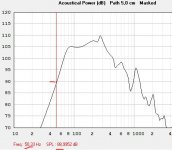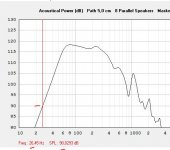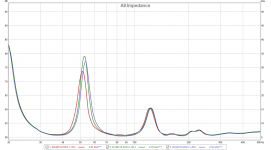Driver coupling.........
GM
... Won't change the cabinet tuning frequency.
The impedance dip stayed in the same place when moving from one cabinet to eight all stacked together. I would have thought that, if there was going to be a shift downwards, eight cabinets put together would've shown it.
Chris
??? Where did me or vtz say/imply anything about it lowering individual cab tuning?
GM
GM, unless I've misinterpretted what's been said earlier in the thread, it looks to me like that's what's been said.
What you need to go down is more of them.
46Hz -3dB with only one, 39Hz -3dB with 4 units, 35Hz -3dB with 8 of them
As axplained by the conceptor it has been optimised for high spl and the octave down is optained by coupling effect of many units as it is expected to be used in big stacks.
The good thing with this design when used in stack is the very large band as it go very high as weel and the high spl.
This would be true enough for stacking sealed, reflex, but for [tapped] horns there will only be a minor drop, which AFAIK is due to the larger effective mouth's end correction increasing its axial path length.
GM
The mechanism of port output cancelling driver output hasn't changed on account of being next to another cabinet, so I see no reason why a large stack of bass reflex cabinets ought to go any lower than a single cabinet.
I can see that the in-band frequency response might change from having a load of drivers putting pressure on each other, but the LF tuning is fixed, and the impedance measurement I took strongly supports that.
Chris
You are correct sir! Just tried it. Now I get why all the venues are doing tons of the 2X18 ported... TL is same as TH right and no effect?
Right, earlier I just mentioned driver coupling, but it's the sum of the all the speakers [driver, etc.] over some [lower] portion of its bandwidth [BW] as 'vtz' originally stated and of course if the array is up against a solid, flat, etc., enough boundary, then this 'mirror' imagine sums it higher plus any added directivity to the point where it's performing ~ like a super large, truncated compression horn with the downside being super expensive to make it easily portable, configurable to obtain different [multiple] polar responses.
No, it will sum also since it's a point source/direct radiator, i.e. couples directly to the 'room' whereas a band pass alignment has one or more [vented] chambers to isolate it.
GM
Last edited:
I'll just post this here as it might be relevant - impedance measurements of my POC3.1 TH loaded into 4PI, 2PI (on the floor) and 1PI (against a wall). There are definite changes in the impedance curve, which imply that the FR will change as well. The question is by how much.
Pulling the data from the graph, the change in the lowest resonance frequency is small (where the phase angle crosses zero).
At 1PI loading, it's at 37.5 Hz
At 2PI loading, it's at 37.7 Hz
At 4PI loading, it's at 37.9 Hz
Note that at 925 cm^2, the mouth of this TH is pretty small. I expect that as the TH's mouth gets larger, the changes will become more significant.
Pulling the data from the graph, the change in the lowest resonance frequency is small (where the phase angle crosses zero).
At 1PI loading, it's at 37.5 Hz
At 2PI loading, it's at 37.7 Hz
At 4PI loading, it's at 37.9 Hz
Note that at 925 cm^2, the mouth of this TH is pretty small. I expect that as the TH's mouth gets larger, the changes will become more significant.
Attachments
GM, unless I've misinterpretted what's been said earlier in the thread........
It's my impression anyway, i.e. a 'can't see the forest for the trees' situation, a problem most [all?] folks suffer from to a greater or lesser extent. For sure it has plagued me over the decades more than I'd like to admit to.
Regardless, measuring efficiency, bandwidth due to close coupling will show that system efficiency, damping has increased, moving towards compression horn performance, so not surprised if measured impedance hasn't shifted as much as HR predicts.
GM
Acoustic coupling of multiple enclosures involves complex summing calculations. Changing the radiation angle can offer an impression of summing but I wouldn't call it a prediction. Besides that changing the radiation angle will make all cabs 'drop' on screen and therefore increase the excursion, it can also introduce dips in the response that don't happen in the real world. Acoustic coupling always improves the response on axis until they no longer act like a point source.
They way I read 'coupling more = more bandwidth', if you use multiple cabs, lets say 8. You do not need to drive them to xmax to reach the operation level (volume) of the location/venue in question. Thus you can lower the HP filter and thus get a wider band without destroying the driver. it's much more logical and makes more sense than 'magically appearing' octaves.

hmm wait it can happen. If you have one Cab or 8 cabs. the lower range got more output automagicaly see below images, 1 cab vs 8 cabs:

90db at 50hz

90db at 26hz

hmm wait it can happen. If you have one Cab or 8 cabs. the lower range got more output automagicaly see below images, 1 cab vs 8 cabs:

90db at 50hz

90db at 26hz
Last edited:
- Status
- This old topic is closed. If you want to reopen this topic, contact a moderator using the "Report Post" button.
- Home
- Loudspeakers
- Subwoofers
- New Marc.O design
